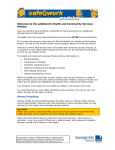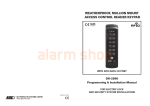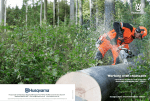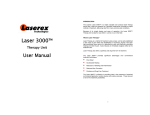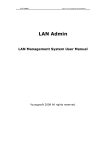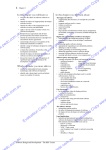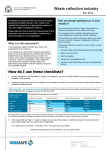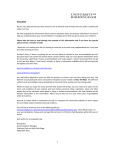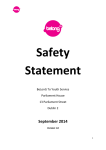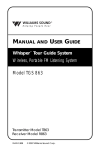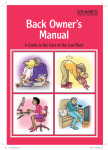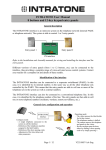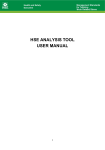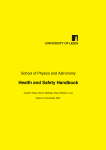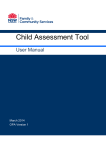Download the General Module of safe@work. - Department of Education and
Transcript
Welcome to the General Module of safe@work. Common hazards exist in many workplaces. It is important to learn about these so you can stay safe while at work. safe@work will: • help you understand occupational health and safety hazards and laws • provide practical solutions to common health and safety problems. Contents: 1. Health and Safety Responsibilities 2. Hazard Identification, Risk Assessment and Risk Control 3. Manual Handling 4. Hazardous Substances and Dangerous Goods 5. Noise 6. Electricity 7. Mechanical Equipment 8. Falls from Height 9. Personal Safety 10. Personal Protective Equipment (PPE) 11. Dealing with an Emergency 12. Health and Safety Laws 13. Duties of Employers 14. Duties of Employees 15. Health and Safety Representatives and Committees 16. The Role of Inspectors 17. Resolving Health and Safety Issues 1. Health and Safety Responsibilities KEY POINT • • Health and safety at work is everyone’s responsibility. Employers have responsibilities towards you You have responsibilities towards your employer and your co-workers. This publication is based on 'WorkSafe Smart Move' (copyright State of Western Australia) published by WorkSafe, Department of Commerce, Western Australia (www.commerce.wa.gov.au/WorkSafe). Your employer is responsible for making sure that the workplace is safe, and that your health and safety are not put at risk. You are responsible for looking after your own health and safety. You must also take care not to put other people at risk. You could put other people at risk by: • • • acting in an unsafe manner not following agreed safe work practices not acting to report a situation which could result in someone getting hurt. To ensure the safety of yourself and others, make sure you are aware of the correct safety procedures at your place of work. This means: • • listening very carefully to safety information provided by your employer asking for clarification, help or instructions if you're not sure about how to perform any task safely. 2. Hazard Identification, Risk Assessment and Risk Control There are three steps used to manage health and safety at work: 1. Spot the hazard (Hazard Identification) 2. Assess the risk (Risk Assessment) 3. Make the changes (Risk Control) At work you can use these three “ThinkSafe” steps to help prevent accidents. Using the ThinkSafe Steps 1. Spot the Hazard KEY POINT A hazard is anything that could hurt you or someone else. Examples of workplace hazards include: • • • frayed electrical cords (could result in electrical shock) boxes stacked precariously (they could fall on someone) noisy machinery (could result in damage to your hearing). During work experience, you must remain alert to anything that may be dangerous. If you see, hear or smell anything odd, take note. If you think it could be a hazard, tell someone. This publication is based on 'WorkSafe Smart Move' (copyright State of Western Australia) published by WorkSafe, Department of Commerce, Western Australia (www.commerce.wa.gov.au/WorkSafe). 2. Assess the Risk KEY POINT Assessing the risk means working out how likely it is that a hazard will harm someone, and how serious the harm could be. Whenever you spot a hazard, assess the risk by asking yourself two questions: • • How likely is it that the hazard could harm me or someone else? How badly could I or someone else be harmed? Always tell someone (your employer, your supervisor or your health and safety representative) about hazards you can't fix yourself, especially if the hazard could cause serious harm to anyone. For example: • • • Ask your supervisor for instructions and training before using equipment Ask for help moving or lifting heavy objects Tell your supervisor if you think a work practice could be dangerous. If you are not sure of the safest way to do something on work experience, always ask your work experience supervisor. 3. Make the Changes KEY POINT It is your employer’s responsibility to fix hazards. Sometimes you may be able to fix simple hazards yourself, as long as you don’t put yourself or others at risk. For example, you can pick up things from the floor and put them away to eliminate a trip hazard. The best way to fix a hazard is to get rid of it altogether. This is not always possible, but your employer should try to make hazards less dangerous by looking at the following options (in order from most effective to least effective): • Elimination - Sometimes hazards - equipment, substances or work practices - can be avoided entirely (e.g. clean high windows from the ground with an extendable pole cleaner, rather than by climbing a ladder and risking a fall). • Substitution - Sometimes a less hazardous thing, substance or work practice can be used (e.g. use a non-toxic glue instead of a toxic glue). • Isolation - Separate the hazard from people, by marking the hazardous area, fitting screens or putting up safety barriers (e.g. welding screens can be used to isolate welding operations from other workers. Barriers and/or boundary lines can be used to separate areas where forklifts operate near pedestrians in the workplace). This publication is based on 'WorkSafe Smart Move' (copyright State of Western Australia) published by WorkSafe, Department of Commerce, Western Australia (www.commerce.wa.gov.au/WorkSafe). • Safeguards - Safeguards can be added by modifying tools or equipment, or fitting guards to machinery. These must never be removed or disabled by workers using the equipment. • Instructing workers in the safest way to do something - This means developing and enforcing safe work procedures. Students on work experience must be given information and instruction and must follow agreed procedures to ensure their safety. • Using personal protective equipment and clothing (PPE) - If risks remain after the options above have been tried, it may be necessary to use PPE such as safety glasses, gloves, helmets and ear muffs. PPE can protect you from hazards associated with jobs such as handling chemicals or working in a noisy environment. Sometimes, it will require more than one of the risk control measures above to effectively reduce exposure to hazards. 3. Manual Handling KEY POINT Manual handling refers to any activity requiring the use of force by a person to lift, lower, push, pull, hold or restrain something. Putting boxes on shelves, painting, gardening, cleaning, writing and typing are some examples of manual handling tasks. Manual handling injuries include: • • • • • • strains and sprains neck and back injuries slips, falls and crush incidents cuts, bruises and broken bones hernia occupational overuse syndrome (OOS). You should be informed and trained in: • • • • • safe manual handling methods specific manual handling hazards safe work procedures use of any required manual handling aids your right to ask for help. Most manual handling injuries can be prevented by designing the task to minimise risk. Instruction, training and supervision are essential to make sure hazards are recognised and safe work methods are used. Even though you may be young and new to the job, you have a responsibility to speak up. Talk to your supervisor if you feel your job is too heavy, too difficult, too tiring or puts you at risk of injury. This publication is based on 'WorkSafe Smart Move' (copyright State of Western Australia) published by WorkSafe, Department of Commerce, Western Australia (www.commerce.wa.gov.au/WorkSafe). KEY POINT It is the employer’s responsibility to provide you with safe work procedures, and with instruction, training and supervision for manual handling tasks. Ways to reduce the risk: • • • • • Lighten loads (break loads into smaller quantities) Reduce the need for bending, twisting, reaching movements Use team lifting Use mechanical assistance (e.g. trolleys and adjustable height workbenches and seating) Prevent muscle strain and fatigue. This includes warming up before working, taking rest breaks, and allowing time to get used to a new task. Slippery floors Slippery and uneven floors in the workplace are hazardous and can result in serious accidents. For example, kitchen workers have been burnt when they have accidentally pulled pots of hot liquid onto themselves when a slip has caused them to fall. Floors should be cleaned regularly so that oil, fat and other spills do not create a slippery surface. Employers must make sure that floors are even, slip-resistant and free from any obstruction that could cause an employee to slip, trip or fall. 4. Hazardous Substances and Dangerous Goods Your workplace may use hazardous substances and dangerous goods. Hazardous substances may be things you see every day such as paint, glue, cleaning liquid and powders. Dangerous goods may be corrosive, flammable, explosive, spontaneously combustible, toxic, oxidising, or water-reactive. They must be identified in the workplace (and when being transported) by different coloured 'diamond' symbols. KEY POINT A hazardous substance is any substance, whether solid, liquid or gas, that may cause harm to your health. Hazardous substances are classified on the basis of their potential health effects, whether acute (immediate) or chronic (long-term). Dangerous goods are classified on the basis of immediate physical or chemical effects, such as fire, explosion, corrosion and poisoning. An accident involving dangerous goods could seriously damage property or the environment. This publication is based on 'WorkSafe Smart Move' (copyright State of Western Australia) published by WorkSafe, Department of Commerce, Western Australia (www.commerce.wa.gov.au/WorkSafe). Harm to health may happen suddenly (acute), such as dizziness, nausea and itchy eyes or skin; or it may happen gradually over years (chronic), such as dermatitis or cancer. Some people can be more susceptible than others. We use hazardous substances and dangerous goods almost every day of our lives. It may be antiseptic for a cut, paint for the walls, or a cleaning product for the bathroom. While they may seem harmless, even these ordinary things can make you very sick if they are not used properly. KEY POINT It is the responsibility of your employer to provide you with safe work procedures for handling hazardous substances and dangerous goods, and to provide information, training and supervision. Material Safety Data Sheet A Material Safety Data Sheet (MSDS) provides detailed information about a hazardous substance or dangerous good. It gives more information than you will find on a label. Manufacturers and suppliers of hazardous substances and dangerous goods are legally required to provide MSDSs to your employer if requested. It is important that hazardous substances and dangerous goods in the workplace are used strictly according to the manufacturer's or supplier's written instructions. Any risk controls specified by the MSDS and the procedures developed by the workplace must also be closely followed. Remember: • • • • • • Follow safe work procedures Always wear the right personal protective equipment and clothing provided by your employer Do not eat, drink or smoke while working with a hazardous substance or dangerous goods Do not keep food or drink near the substances Wash your hands and face and other exposed areas with soap and water before going to the toilet, eating and drinking Read the MSDS before using any hazardous substance. If there is no MSDS, ask your employer or supervisor to obtain one. 5. Noise When someone loses their hearing, it can be devastating for them and annoying for others around them. People with poor hearing are often left out of conversations and social activities. Hearing loss can also cause people to become less efficient at work and study. Some early warning signs of hearing loss include: • • ringing in the ears after doing something which exposes you to noise having trouble understanding what people say This publication is based on 'WorkSafe Smart Move' (copyright State of Western Australia) published by WorkSafe, Department of Commerce, Western Australia (www.commerce.wa.gov.au/WorkSafe). • • needing to turn up the volume on the radio or television, even though other people can hear not hearing background noises like the telephone or doorbell. KEY POINT If employees experience any of the warning signs of hearing loss, they should talk about ways to control and reduce their exposure to the noise with their supervisor and their health and safety representative. As a general rule, if the noise around you forces you to raise your voice to make yourself heard by someone a metre away, your hearing may be at risk. The scale used to measure noise as it is heard by the human ear is written as dB(A). Normal conversation is about 60 dB(A) to 65 dB(A). 85 dB(A) is the level at which you have to raise your voice, while at 90 dB(A) you will have to shout to make yourself heard. Prolonged exposure to noise above the level of 85 dB(A) significantly damages hearing. This is the level at which noise control measures must be taken by employers. The table below is a guide to some typical noise levels. Noise Sources Heavy traffic Lawn mower Angle grinder Chainsaw Noise Level dB(A) (at operator’s ear) 80 90 105 105 Every effort must be made to reduce noise at its source. However, if there is no way to separate people from potentially damaging causes of noise, an employer must provide the correct personal hearing protectors (earmuffs or earplugs). These should be used only as a temporary measure or last resort. Personal hearing protection should be regularly cleaned and any damaged parts must be replaced. Personal hearing protection should be kept near the area of noisy activity. Listening to music through headphones does not provide protection from noise. To help reduce the risk of hearing loss you could also spend less time being exposed to noise. It's up to employers to make sure that no employee is exposed to noise for longer than the prescribed exposure standard. KEY POINT People do not adapt to noise. It only seems that way because they have lost their hearing. Lost hearing is gone forever. Exposure to noise outside work can also be dangerous to your hearing. Noise in nightclubs and pubs, as well as from personal sound systems, can exceed levels that would be acceptable in the work place. This publication is based on 'WorkSafe Smart Move' (copyright State of Western Australia) published by WorkSafe, Department of Commerce, Western Australia (www.commerce.wa.gov.au/WorkSafe). 6. Electricity Electric shock happens when a person becomes part of an electrical circuit and the current flows through their body. When an electric shock kills someone it is called electrocution. Accidents and deaths can occur when equipment becomes 'live' due to electrical faults, lack of maintenance, or short circuits. Doing maintenance work on live electrical circuits is another common cause of electrocution. Electrical accidents are usually caused by a combination of factors such as: • • • • lack of training or supervision unsafe work practices equipment not properly installed, maintained, tested and tagged a hazardous work environment, where electrical hazards may not be recognised. Electrocution often occurs when people misjudge heights and distances between the ground and overhead wires when carrying equipment like poles and ladders, or operating equipment with height extension such as cranes. Remember, 'Look Up and Live'. General safety precautions • Apprentices, trainees and work experience students must be supervised at all times by a qualified worker, and must never attempt to carry out any work that could expose them to an electrical hazard. • Only licensed electrical workers can legally do electrical work. An unqualified person must not be asked to do electrical work. • Keep powered tools and equipment in safe working order through inspection and preventative maintenance programs. • Disconnect and report faulty tools and appliances - for example, frayed cords or broken power points. Even after a piece of electrical equipment, appliance or machine has been disconnected from the power source, it may still partially operate. This is because of stored energy within the equipment. After disconnecting the power source, activate the machine or appliance to release the stored energy. • Always switch off tools and appliances at the power point before pulling out the plug. • Keep electrical cords off the floor to reduce the risk of damage from dragging, contact with sharp objects or contact with water. A damaged electrical cord can cause electrocution. • Know the location of your main electricity supply. • Check the location of overhead wires and stand clear of any fallen power lines. • Use your appliance properly. Read the instruction booklet and follow all instructions. • Electricity and water don't mix. Bare feet and wet skin lower the body's resistance to electricity. Keep electrical appliances and electrical leads away from water and wet areas. • Don't overload circuits and fuses by using too many appliances from the one power point. Don't use double adaptors to 'piggy back' plugs. Use a power board with individual switches. This publication is based on 'WorkSafe Smart Move' (copyright State of Western Australia) published by WorkSafe, Department of Commerce, Western Australia (www.commerce.wa.gov.au/WorkSafe). • Employees who use portable electrical equipment at workplaces must be protected against earth leakage by a Residual Current Device (RCD), also known as a safety switch. 7. Mechanical Equipment Mechanical equipment (plant, machinery and hand-held power tools) can cause serious injuries, including open wounds, fractures and amputations. Some injuries can result in death. Sprains and strains often result when mechanical equipment is used incorrectly. Bad working posture contributes to many such injuries. The most common mechanical equipment injuries are to hands and fingers, which may be cut, sprained, dislocated, broken, crushed or cut off by machinery or tools. Eye injuries can be caused by heat or radiation, or by objects thrown from moving mechanical parts. KEY POINT Your workplace must have a maintenance program to ensure that all equipment and machines are in safe working order. Mechanical equipment injuries can cause long periods of time off work, and sometimes permanent disability. Many such injuries happen in the construction, agricultural and manufacturing industries. When working with mechanical equipment, personal protective equipment may include protective gloves, arm guards, safety glasses, hard hats and safety boots. Guards Guards attached to mechanical equipment protect you from the moving parts of machines. Machine guards must never be removed and if a guard is damaged or missing, the machine must not be used until it can be repaired or replaced. A missing or damaged guard must be reported at once. If guards are removed during cleaning, make sure they are replaced and checked by an authorised person before the machine is used. Never start machinery during cleaning. ‘Locking out’ equipment Locking out is one way of stopping electrically powered machinery from starting during maintenance. A lock is attached to the machine switch so it can't be turned on. The person working with the machine should hold the only key to the lock. A lock must only be removed by the person who attached it to the equipment or machinery. Procedures must be put in place for the removal of the lock should that person not be available (for example, if there has been a change of shift workers, or if the person authorised to remove the lock has been called away). This publication is based on 'WorkSafe Smart Move' (copyright State of Western Australia) published by WorkSafe, Department of Commerce, Western Australia (www.commerce.wa.gov.au/WorkSafe). ‘Danger’ and ‘Out of Service’ Tags Red and black 'DANGER' tags are designed for the protection of individual people. The only person permitted to remove a personal 'DANGER' tag is the person whose name is on the tag. Yellow and black 'OUT OF SERVICE' tags are used to prevent accidents or damage to machinery that is out of service for repairs. KEY POINT Any faulty equipment should be tagged so that it cannot be used until it is replaced or repaired. The safe work procedures for removal of 'DANGER' and 'OUT OF SERVICE' tags at your workplace must be followed. KEY POINT Apprentices, trainees and work experience students must be supervised at all times by a qualified worker. 8. Falls from Height Identifying Fall Hazards Falls are a major cause of workplace fatalities and serious injuries. There are many jobs that require people to work at heights greater than 2 metres, or at ground level where a fall is possible because of hazards like holes, pits or shafts. Examples of typical fall hazards include: • • • • • • • work on or near fragile roof surfaces such as skylights or fibreglass panels with no guarding, safety mesh or other fall protection measures present installation, maintenance or inspection of air conditioning units situated close to unprotected roof edges work from ladders – such as painting, repairing or clearing gutters tree work which requires climbing to reach the branches to be pruned raising workers on pallets to reach items stored in high racking or shelving climbing onto the tops of vehicles such as tankers or livestock carriers mezzanine floors without adequate guardrails or handrails. Reducing the risk of falls Employers must take steps to safeguard workers against falls. Victorian law now requires every task which involves a fall hazard of more than 2 metres to be assessed, to see whether it can be done safely from the ground or from a stable work platform. For example, equipment mounted on a roof can often be relocated to ground level. If those options are not practicable, there are a number of other risk control measures that could provide the protection needed. They include: This publication is based on 'WorkSafe Smart Move' (copyright State of Western Australia) published by WorkSafe, Department of Commerce, Western Australia (www.commerce.wa.gov.au/WorkSafe). • • • using an industrial rope access system, to enable the worker to supported by ropes which are attached to a strong anchor point setting up a passive fall prevention device – such as a scaffold or guardrail using a fall injury prevention system, such as an industrial safety net or safety harness system. All of these require specific training and instruction for the worker, and purpose-designed equipment which must be regularly checked for any wear or damage. The use of ladders Where the use of a ladder is the only practicable way to do a job requiring work above 2 metres, employers must make sure the ladder is appropriate to the task. Ladders should be ‘tied off’ where practicable to ensure that they are stable and will not slip sideways or fall backwards. Where a job requires that a ladder is used frequently, a ladder bracket may be fitted to enable to the worker to secure the ladder before work begins. Ladders should always be carefully checked before use, and should never be used where the ground is sloping or soft. Tools and equipment should never be carried up or down a ladder – they should be raised and lowered in a bag. A person on the ground can do this, while at the same time keeping watch for pedestrians and other traffic. 9. Personal Safety Working alone Many people in remote places have to work alone. A person is alone at work when they can't be seen or heard by another person. People who work away from other people and settlements, such as employees on farms or stations, or in forest operations, can often be at risk. People may also have to work alone in towns and cities. They include people who work: • • • • • • where there are no other employees when everyone else has gone home inspecting large structures such as cranes, when nobody else is close by cleaning offices in high rise buildings outside normal business hours in parks and reserves inspecting vacant land for fire. Things that may increase the risks involved with working alone include: • • • • • how long the person may be working alone what time of day the person may be working alone lack of communication tools such as a telephone the location and accessibility of the work site the skills, experience and character of the person working alone. Some tasks (for example, working with powered tools like chainsaws) should never be done while working alone. Other tasks must be carefully assessed by employers before they are considered suitable for a lone worker. Arrangements for contact and emergency must always be made before work starts. This publication is based on 'WorkSafe Smart Move' (copyright State of Western Australia) published by WorkSafe, Department of Commerce, Western Australia (www.commerce.wa.gov.au/WorkSafe). To reduce the risk of injury or harm to health, employers should provide information, instruction and training for people who work alone. It is also essential that the person knows the work well, and the work procedures that should be followed. KEY POINT Students doing work experience and structured workplace learning must be supervised at all times and must never be expected to work alone. Work-related stress No job is free from stress. All work involves some responsibilities, problems, demands and pressures that may be stressful. Some level of stress can be expected to occur from time to time in most jobs. KEY POINT Stress is usually described as a reaction in people to heavy demands, pressures and expectations. Usually people who are stressed feel a sense of loss of control over their lives, or that they can't cope. Not all pressure is harmful. People are often kept motivated by challenges and difficulties they face and are able to solve at work. However, there is a limit to how much pressure people can deal with. Performance can drop, mistakes can happen, and the health of the employee may be adversely affected. Generally, periods of stress don't last very long and will have little or no long-term effect. When relief from a stressful situation is not available or when the relief is for a short period only, the body has no time to repair, and the stress becomes long lasting and more serious. Long-term problems emerge and recovery time, even with professional help, is much longer. You should talk to your supervisor if you feel unduly stressed at work. Employers can do things to reduce work-related stress. These include making sure workers are treated fairly, rotating (sharing) the more boring, repetitive or demanding tasks and providing access to ‘peer support’ and counselling services for workers in potentially stressful jobs (such as health care or emergency work). KEY POINT There will always be times at work when you experience some stress. Talking to others about your concerns often eases the pressure. Keeping fit and healthy will increase your ability to deal with stress. This publication is based on 'WorkSafe Smart Move' (copyright State of Western Australia) published by WorkSafe, Department of Commerce, Western Australia (www.commerce.wa.gov.au/WorkSafe). Violence and bullying at work Workplace violence and bullying is an action, incident or pattern of behaviour that harms, injures or upsets another person. It includes situations where employees and other people are threatened, bullied, intimidated, pushed or struck. Workplace bullying and harassment should not be tolerated. Employers must take steps to protect employees and other people in workplaces from incidents that may cause injury or harm, and from situations where they are victimised or bullied. People who work alone or at night (e.g. taxi drivers, video store attendants) and people who handle things like cash or drugs (e.g. bank tellers, chemists) may face added risks, such as robbery or assault. If you are bullied at work, inform your supervisor, employer or a trusted colleague. Students should also inform their teacher and their parent or guardian without delay. Employers must take immediate action to stop bullying whenever it is noticed or reported. KEY POINT You are not expected to deal with harassment and bullying yourself. Inform your supervisor or someone you can trust. 10. Personal Protective Equipment Types of PPE and protective clothing Personal protective equipment and clothing includes: • • • • • • • overalls and protective aprons protective headgear - safety helmets, wide brimmed hats to protect against the sun safety boots or shoes safety glasses or goggles gloves respirators and masks earmuffs and earpieces. Use of PPE KEY POINT When hazards in the workplace can't be eliminated or sufficiently reduced by other risk controls, employers must provide personal protective equipment and clothing (PPE). Employees must be instructed in how to use PPE and clothing provided by the employer. They should be told why the use of PPE is necessary before they start the particular job for which it has been provided. Where PPE is provided, you must use it as you have been instructed to do. This publication is based on 'WorkSafe Smart Move' (copyright State of Western Australia) published by WorkSafe, Department of Commerce, Western Australia (www.commerce.wa.gov.au/WorkSafe). Employers should make sure that the PPE they purchase complies with the relevant Australian Standard. They must make sure that PPE is stored in a clean and fully operational condition, that it can be easily found when needed and that it is safe from interference and damage. PPE should be inspected regularly and before use to make sure it is in good working order. Damaged or defective PPE must be reported at once. It must be tagged (to prevent its use until it has been repaired), or thrown away and replaced. 11. Dealing with an Emergency Incidents and accidents sometimes happen in workplaces, so you must know what to do in an emergency. Every workplace is different, so it is important that you are told where to find trained first aiders, who your fire wardens are and the emergency evacuation procedures for your work location. KEY POINT Listen carefully when you are told about the first aid and emergency arrangements at your workplace. If you are still not sure, ask for further information. First aid facilities If you or your workmates are involved in an accident, first aid is crucial. Your employer must provide first aid facilities and must tell you where they are. For example, they could be: • • • in a room set aside specifically for first aid treatment at a number of first aid stations within the workplace in a first aid box on a wall. Make sure you find out what first aid facilities you have at your workplace and who your first aiders are. Fire extinguishers Your employer must tell you where fire extinguishers are located, what types of fire they are suitable for, who is authorised to use them and who your fire wardens are. Alarm signals If there is a fire or emergency, an alarm of some kind will sound. You must be able to identify the alarm signals so you know what they mean. Your employer must provide training so you know what to do and where to go if there is an emergency. This publication is based on 'WorkSafe Smart Move' (copyright State of Western Australia) published by WorkSafe, Department of Commerce, Western Australia (www.commerce.wa.gov.au/WorkSafe). 12. Health and Safety Laws KEY POINT Victoria's occupational health and safety laws aim to make workplaces safer and prevent work-related deaths, injuries and diseases. The Occupational Health and Safety Act 2004 The Occupational Health and Safety Act 2004 (called the OH&S Act for short) covers most workplaces in Victoria including offices, hospitals, schools, factories, construction sites, farms, forests, boats, vehicles and any place where employees or self-employed people work. The mining and petroleum industries and Commonwealth government workplaces are covered by separate health and safety laws. The Government, employers and unions developed the OH&S Act through talking and working together. The Act allows employers and employees to deal with workplace health and safety through consultation (discussion) and co-operation (team work). Consultation between employers and employees in workplaces is very important. The Act encourages discussion, particularly through employee health and safety representatives and health and safety committees made up of both management and employee representatives. Under the Act, everyone involved with work has responsibilities for occupational health and safety. Occupational Health and Safety Regulations Regulations are laws made by government to support Acts – in other words, to set out more detailed requirements which will help to an Act to achieve its objectives. The OH&S Act is supported by the Occupational Health and Safety Regulations 2007, which make specific requirements in regard to hazards, including: • • • • • • • Manual Handling Noise Plant Prevention of Falls Hazardous Substances Asbestos Lead. Hazard identification, risk assessment and risk control are made compulsory by the Regulations for employers in all workplaces. The Regulations also address things like the issuing of licences for erecting scaffolds, operating cranes and forklifts and other potentially dangerous work. This publication is based on 'WorkSafe Smart Move' (copyright State of Western Australia) published by WorkSafe, Department of Commerce, Western Australia (www.commerce.wa.gov.au/WorkSafe). KEY POINT Regulations are laws to protect people against occupational injury and disease. Every workplace in Victoria must obey all the laws relevant to their work. The OH&S Act and Regulations are legally enforceable, and employers can be prosecuted if they do not meet their obligations. These laws give every person in every workplace a right to be involved in health and safety through a process of consultation and co-operation. They also provide penalties for any employer or employee who tries to prevent this process from happening. KEY POINT Employers and employees should work together to eliminate hazards and to find practical ways to protect the health and safety of everyone in the workplace, including members of the public. Duty of care The Occupational Health and Safety Act 2004 contains sections that describe the responsibilities of: • • • • • • employers employees self-employed persons persons who have control of workplaces (eg. owners or managers) persons who manufacturer or supply plant (machinery or equipment tools) and substances used at work persons who design or construct buildings and structures. These responsibilities are known as 'duties of care'. The duty of care applies to each person 'as far as is reasonably practicable'. 'Practicable' means reasonable measures must be taken, bearing in mind: • • • • the severity of any injury or harm to health that may occur the likelihood of the injury or harm occurring how much is known about the hazard and the ways of reducing, removing or controlling it, and the availability, suitability and cost of safeguards. 13. Duties of Employers An employer's main responsibility is to make sure that the workplace is safe and that anyone working in or visiting the workplace is not exposed to hazards or harmed by the work. For example, the employer must: This publication is based on 'WorkSafe Smart Move' (copyright State of Western Australia) published by WorkSafe, Department of Commerce, Western Australia (www.commerce.wa.gov.au/WorkSafe). • make sure that work areas, machinery and equipment are kept in a safe condition. • organise ways of working safely • provide information, instruction, training and supervision of employees so they can work safely • make sure that employees are aware of potential hazards • provide protective clothing and equipment where hazards can't be avoided • consult and co-operate with health and safety representatives and other employees at the workplace • inform employees about hazards in the workplace, and improve their understanding of safe work procedures. (The information does not always have to be written - it can be spoken, or in the form of videos and tapes) • provide new employees with specialised induction training to help them become familiar with their new work environment, procedures, equipment and materials so they can do their job safely. Induction should be much more than having a chat with your supervisor, completing a few forms and being introduced to your workmates • provide information about hazards and the actions taken to control workplace risks (including the use of personal protective equipment where necessary) • provide supervision to ensure that employees are not exposed to hazards. Supervision should include regular checks to make sure health and safety instructions are being followed • consult with employees to identify and control hazards in workplaces. Employees who are experienced in a job will usually know what can go wrong, and why • consult with employees and health and safety representatives on health and safety matters • make sure equipment and materials are used, stored, transported and disposed of safely. 14. Duties of Employees Once you have been properly trained and instructed you must take care to look after your own health and safety and not put other workers at risk. Your responsibilities include: • • • • • • following health and safety instructions provided by the employer correctly using personal protective equipment and clothing taking care to use equipment safely and for its intended purpose reporting hazards and potential problems without delay reporting all work-related injuries and incidents that you think could result in harm to health co-operating with the employer on health and safety matters. This publication is based on 'WorkSafe Smart Move' (copyright State of Western Australia) published by WorkSafe, Department of Commerce, Western Australia (www.commerce.wa.gov.au/WorkSafe). KEY POINT Remember that co-operation and consultation are the keys to a safe and healthy workplace. Employers and employees should talk to each other to solve health and safety problems at work. 15. Health and Safety Representatives and Committees Health and safety representatives (HSRs) Health and safety representatives (HSRs) are an important link between employees and employers. They tell employers about health and safety concerns and co-operate with them to set up and maintain workplace safety. (HSRs) are elected by co-workers to act on their behalf in resolving health and safety issues in the workplace and to maintain safe working conditions. Employees at every workplace are allowed by law to elect their own HSR. KEY POINT Having a health and safety representative at your workplace makes it easier to bring health and safety problems to the attention of management so they can be dealt with and resolved. When an employee asks for the election of a health and safety representative, the employer and employees must work together to conduct an election at the workplace. An employer may also call for the election of a health and safety representative without waiting for employees to ask. KEY POINT Young employees should be introduced to their health and safety representative as part of their health and safety training when they first start their job. As a new worker, you can ask the HSR to help you recognise and avoid health and safety hazards and risks in areas where you will be working. Many organisations also have health and safety officers, who are not elected by employees. These officers are appointed by employers to manage occupational health and safety issues in the workplace and make sure health and safety induction, information, training and supervision are provided for employees. Regular inspections of the workplace by HSRs are usually arranged with the employer in advance, but may be done without notice if there is an accident, dangerous situation, or immediate risk to health and safety. This publication is based on 'WorkSafe Smart Move' (copyright State of Western Australia) published by WorkSafe, Department of Commerce, Western Australia (www.commerce.wa.gov.au/WorkSafe). Health and safety committees Any employee may request that a health and safety committee is set up. Once an employee has asked for a committee, the employer is required by law to take steps to establish one. Employers may also establish a health and safety committee on their own initiative. Committees are useful as they help employers and employees to work together to make the workplace safe. In some larger workplaces, several health and safety representatives may be elected. There may also be more than one committee. Major employers may have health and safety representatives and committees at various workplaces around the state. 16. The Role of Inspectors WorkSafe inspectors are responsible for enforcing health and safety legislation (Acts and Regulations). They have wide-ranging powers to help them fulfil their functions. Inspectors have powers to: • • • • • • • enter, inspect and examine workplaces conduct investigations and enquiries take samples, photographs, records and measurements take possession of materials ask that the workplace be left undisturbed interview anyone at the workplace ask for assistance from anyone at the workplace. Inspectors have to avoid unduly or unreasonably interfering with the work being carried out in any workplace. Inspectors may issue written directions called Improvement Notices and Prohibition Notices. Improvement and Prohibition Notices An Improvement Notice is a written direction requiring a person to fix a health and safety problem in a workplace. The Notice will state the part of the Act or Regulations covering the offence and will set a date by which the improvement must be completed. A Prohibition Notice is a written direction that prohibits, at once, any activity where the inspector thinks someone may be at risk of serious harm. The inspector will remain at the workplace until the employer has been told about the Notice and the activity has stopped. KEY POINT In Victoria, WorkSafe inspectors may issue improvement or prohibition notices. Health and safety representatives may issue provisional improvement notices. Improvement and Prohibition Notices give reasons explaining why they been issued and may set out specific actions which must be taken to fix the problem. This publication is based on 'WorkSafe Smart Move' (copyright State of Western Australia) published by WorkSafe, Department of Commerce, Western Australia (www.commerce.wa.gov.au/WorkSafe). The employer must display the Improvement or Prohibition Notice in a place where it can be easily seen, at or near any work area affected by the Notice, until the requirements of the Notice have been met. A person who has been issued a Notice, or that person's employer, can ask for a review of the Notice if they disagree with the inspector's opinion. Such appeals must be made in writing, within seven days of receiving the Notice. 17. Resolving Health and Safety Issues Employers, employees and health and safety representatives are encouraged to co-operate in order to resolve health and safety issues. If you are working on a task that you believe is unsafe or unhealthy you can take the following steps: 1. Talk to your supervisor and health and safety representative about the problem. If the issue cannot be resolved, go to the employer. 2. Try to agree on ways to fix the problem. If you are in danger, you may be given different work to do until the risk has been dealt with. 3. If you cannot agree upon a safe course of action, your employer or health and safety representative may ask a WorkSafe inspector to visit. 4. Inspectors take whatever action they consider appropriate. Improvement and Prohibition Notices may be issued. The right to refuse work If you believe the work you are doing is dangerous and there is a risk of serious injury or harm to yourself or others, then you can refuse to do this work. You must tell your supervisor (or employer) and your health and safety representative of your concerns. KEY POINT An employer can give you other work to perform, away from the danger, while the issue is being addressed. If you have refused to work on reasonable grounds, you must receive the same pay and other benefits (if any) that you usually get. This is not the case if you have left the workplace without the authorisation of the employer or if you have refused to do reasonable alternative work. Multiple Choice Questions You may now try the multiple choice test. See your teacher for a copy and full instructions. There are 16 questions. If you get 12 or more correct you are entitled to an Award of Attainment. The Principal of your school will sign the Award and validate it with the school stamp. This publication is based on 'WorkSafe Smart Move' (copyright State of Western Australia) published by WorkSafe, Department of Commerce, Western Australia (www.commerce.wa.gov.au/WorkSafe).





















